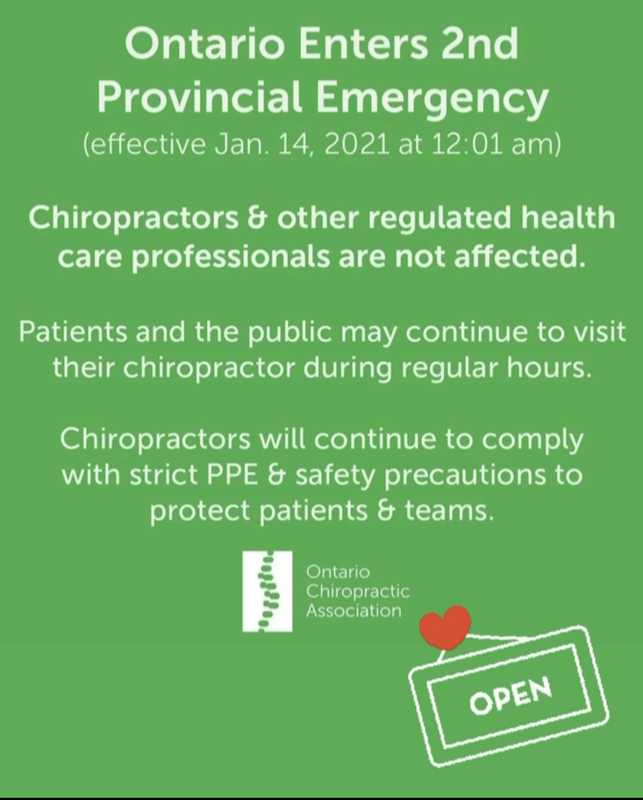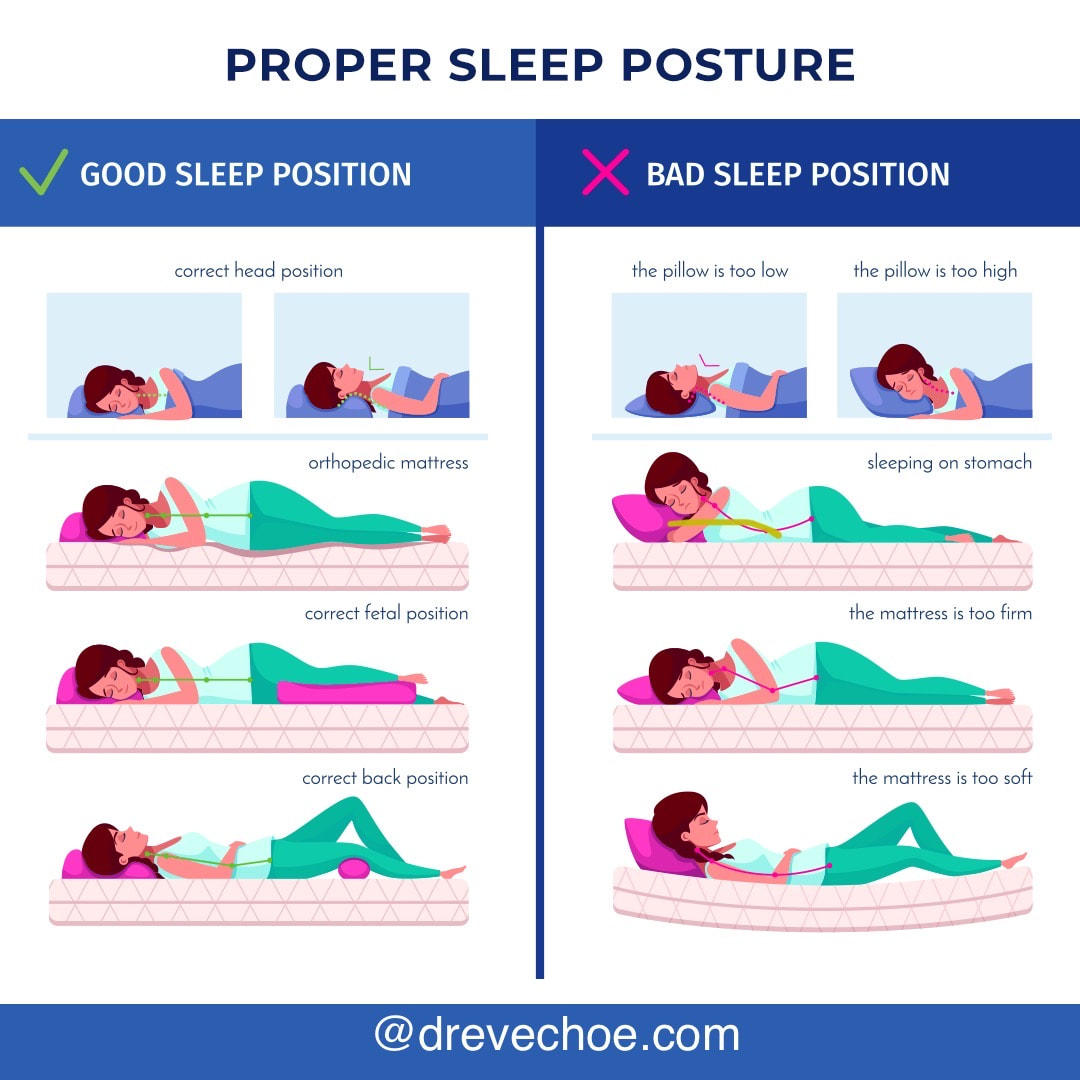|
Things will look a bit different in the office as we have made many changes to keep you and your family, and our team safe.
What we are doing to ensure your safety during your visit:
I often find poor sleeping habits contribute to chronic neck or back issues. A question I commonly get asked is: what is the best way to sleep for good posture? Read on to find out.
✅Sleeping on your back or side keeps your spine in the most neutral position, If you choose to sleep on your side, make sure to support your pelvis with a pillow between your knees. ✅Take a look at the type of pillow that you use. If you sleep on your back, you need a lower pillow. Remember that the neck is what really needs to be supported vs. your head. If you sleep on your side. there’s a bigger negative space between your head and shoulder, so you need a firmer and higher pillow. ✅Tuck the bottom of the pillow above the shoulders. The pillow should support your neck, not your shoulders. ✅Medium-firm mattress is best. A mattress that is too soft will cause the heaviest parts of your body to sink, while a too firm mattress will not support the curves of the spine. A good sleeping posture will improve the quality of your sleep, improving your overall energy and mood. Sweet dreams! Happy Posture Month! In honour of posture month, I will be posting posture tips on my Instagram page @drevechoe as well as some on the blog throughout the month of May.
How to fix the habits causing your bad posture so it doesn't ruin your look — or your backWritten by: Andrea Kerr for The Werk
If you work from a couch, or even from a desk, you've probably made peace with hunched shoulders and a mildly achy neck — but did you know that slouched posture has serious consequences for your image and your health? “If you have bad posture, people assume that you’re not confident,” says Eve Choe, a Toronto-based chiropractor who offers a 12-week posture workshop at her clinic. “You appear shorter and people assume you’re tired.” Poor posture also has negative health consequences like “chronic fatigue, muscle fatigue, headaches and back pain. You can have sleep and digestive problems, difficulty concentrating. It causes so many issues,” Choe says. But contrary to popular belief, super-straight military posture is not the ultimate goal. Instead, “good posture maintains three natural curves in the spine at the neck, mid-back, and low back,” says Choe. When you look in the mirror, your eyes should be level, as should your shoulders, hips, knees, and ankles. From the side, your ears, shoulders, hips, knees, and ankles should create a straight line that, again, maintains the natural curves in the spine. If you frequently notice that you appear slouched in photos or videos — or that your grandma’s always bugging you to sit up straight — try these tips for correcting the habits that cause bad posture in the first place. 1. Check your smartphone. Lately, the most common form of bad posture that Choe sees at her clinic is the forward head tilt — and one of the main causes is smartphone use. Many people spend hours on their phones each day texting, answering emails, and posting on social media, and they hold their phones in their laps, which causes neck strain. The correction? “Bring your smartphone to eye level instead of bringing your head down to it,” says Choe. 2. Adapt your workspace. “Laptops are built for portability,” Choe notes. “They’re not built for our bodies. Often, we will hunch forward so we can have our eyes level with the monitor of the laptop.” To correct this posture, consider purchasing an external keyboard or monitor so that you can space them to work for your body when your posture is at its best. Also, try to avoid sitting on soft couches or armchairs to work because they will likely raise your knees above your hips, which then rounds out your lower back. Instead, choose a chair that allows you to sit directly on your sit bones (not on your tailbone) with your knees at 90 degrees to your hips. 3. Take frequent breaks. It’s time to curb your habit of staring at your computer screen for three, four or five hours straight — even if you have the perfect office set-up. “A good tip is 20-20-20,” says Choe. “So every 20 minutes, try to get up for 20 seconds and look 20 feet away. It also gives your eyes a break.” If you can’t break every 20 minutes, aim for every hour. 4. Think long. Don’t think “straight” when you’re trying to correct your posture, because a healthy spine isn’t straight. Instead, imagine a string attached to the top of your head and pulling you upwards. Your shoulders should be back, yet relaxed, and you should maintain the natural curves in your spine. 5. Work it out. When working to correct bad posture, Choe gives her clients plenty of exercises to do at home. She loves head retraction and scapula retraction exercises, in particular. “For head retractions, you bring your head in toward the body with your chin tucked,” she says. “You don’t look down. You don’t look up. You bring your head straight back. With a scapula retraction, you squeeze your shoulder blades together.” Choe also likes to strengthen the muscles that stabilize her clients’ shoulder blades by recommending wall angels, which are snow angels performed up against a wall. 6. Change your sleep habits. How you sleep each night can have an effect on your posture throughout the day. “Sleeping on your back keeps your spine in the most neutral position, but side sleeping is also good,” says Choe. If you choose to sleep on your side, make sure you support your pelvis with a pillow between your knees. Also, take a look at the type of pillow that you use to support your head. If you sleep on your back, you need a low pillow. If you sleep on your side, “there’s a bigger negative space between your head and shoulder, so you need a firmer and higher pillow.” 7. Book an appointment with a chiropractor. A chiropractor can make adjustments that “restore mobility and movement back into the joints in the spine,” says Choe. These adjustments can also relieve stress that’s placed on the body when there’s a locked or restricted joint. After your adjustments, ask your chiropractor for additional at-home exercises to correct your specific posture concerns. Bad posture is a habit that you’ve developed over several years. Give yourself the time to correct it (Choe says it will likely take at least 12 weeks) and you’ll see improvements in your health and the image that you project to your colleagues, employers and future clients.  Did you know that at least half of pregnant women experience back pain? And 10% of those report discomfort severe enough to disrupt their daily routines. The good news is that there are steps you can take to protect your back during pregnancy. What causes pregnancy-related back pain in the first place? When pregnant, it’s normal to gain more than 30 pounds. This extra weight places considerable stress on your back, feet, ankles and knees. As your baby grows, your core abdominal muscles become stretched and cannot stabilize your posture as well as they did before. In the third trimester, levels of a hormone called “relaxin” increase by a factor of ten. Relaxin loosens your joints to allow the pelvis to accommodate the enlarging uterus. These loose joints force the muscles of the back and pelvis to work overtime to keep you upright and balanced, leading to back pain. TRY THESE TIPS TO HELP MINIMIZE YOUR RISK OF BACK PAIN: Exercise Exercise can go a long way to increase muscle support for an aching back. A health care practitioner should always be consulted before starting a new exercise regimen. Low impact cardiovascular activities, such as swimming, walking, or stationary cycling can help relieve pain and maintain fitness. Sleep Position Sleep on your left side to reduce the pressure of your uterus on the large blood vessels in your abdomen, optimizing blood flow to both you and the baby. Pillow Position Place a pillow between your knees to take pressure off your lower back when sleeping on your side. Support Your Body With the added weight, support has never been more important. Wear flat, supportive shoes and use a lumbar support pillow in your chair at home or work. If you sit at a computer or desk, walk around for a few minutes each hour. Take Breaks Take frequent, short breaks with your feet elevated. Adequate rest restores your energy and gives your back a chance to relax. Get Adjusted Regularly Chiropractic care throughout pregnancy balances your pelvis, eliminating undue tension to muscles and ligaments and enhancing optimal fetal positioning. courtesy of the Ontario Chiropractic Association. Pregnancy is an exciting time in a mother-to-be’s life. Although joyous, expectant mothers undergo significant amount of changes as the baby develops. The back, neck and joints are the areas of body that tend to suffer the most. Along with an OBGYN, a chiropractor is a welcome addition to a woman’s prenatal care team. Chiropractors can help manage back and joint pain issues so that they don’t become an issue during delivery or impact a woman’s recovery time post-pregnancy. Here are 5 key ways chiropractors can help:
1. Chiropractic care keeps the spine in alignment Pregnancy adds significant additional weight to a woman’s body in a short amount of time. This change bears on the spine, frequently pulling it out of alignment. When this happens, the pain can be quite severe. Chiropractic care during pregnancy works to keep the spine in alignment and all supporting tendons working optimally, to be better prepared and able to adequately support the extra weight. 2. Chiropractors can reduce the need for pain relievers by treating underlying issues. Most times, individuals experiencing moderate pain pop a couple of over the counter pain relievers and think nothing of it. However, pregnant women strive to avoid medications when possible. Chiropractic adjustments decrease the underlying issues that cause pain, so the patient relies less on medications. Experiencing less pain as well as eliminating the need for pain killers is a win-win situation for expectant mothers. 3. Chiropractors can help strengthen joints. Pregnancy really beats up an expectant mothers joints. Chiropractic care for expectant mothers is a productive way to minimize the effect the large, protruding abdomen has on her hips, legs, and ankles. Treating the body as a whole, chiropractic treatment works to strengthen the body and promotes healing of injured or strained areas. 4. Chiropractors can help achieve pelvic alignment making the birth process go more smooth. An aligned pelvis is critical to the birthing process, and increases the chances of being able to give birth naturally. According to the American Pregnancy Association, “When the pelvis is misaligned it may reduce the amount of room available for the developing baby. This restriction is called intrauterine constraint. A misaligned pelvis may also make it difficult for the baby to get into the best possible position for delivery. This can affect the mother’s ability to have a natural, non-invasive birth.” An experienced chiropractor can effectively align the pelvis before delivery, so the mother is able to deliver with little incident. 5. Chiropractic care increases the body’s ability to bounce back Let’s face it, every pregnant woman thinks “will I ever fit in the clingy red dress again?” The healthier and stronger a woman’s body is before and during pregnancy, the easier it is to get back into shape once the baby is born. Eating right and safely exercising are effective ways to accomplish this. Chiropractic care is also a valuable component to fitness. Expectant mothers who choose chiropractic enjoy better posture, less pain, and increased mobility, especially late in the third trimester. This allows them to maintain exercise routines and be active longer than those suffering from back pain and achy joints. After the delivery, it’s easier to get back into a fitness routine, and into that red dress, if the new mother’s joints, back, and hips are aligned and functioning properly. Chiropractic care can serve to reduce pain and increase the overall heath of expectant mothers, letting her relax and focus on the more pleasant aspects of pregnancy. Expecting women who commit to chiropractic care can look forward to a stronger body, the chances of a smoother delivery, and an easier recovery after the baby comes. This article excerpt, by Porterfield Family Chiropractic, was published June 15, 2015 and originally appeared here. Sitting is the new smoking. You've heard it many times now. What can you do while sitting in front of a computer other than taking frequent breaks? Try this simple posture correction throughout the day: |
AuthorDr. Eve Choe is a Toronto-based chiropractor, and certified posture expert, acupuncture & orthotics provider. Archives
November 2023
Categories
All
|

|
|








 RSS Feed
RSS Feed